BOR I CELICI LEGIRANI BOROM - Mašinski fakultet u Zenici
BOR I CELICI LEGIRANI BOROM - Mašinski fakultet u Zenici
BOR I CELICI LEGIRANI BOROM - Mašinski fakultet u Zenici
You also want an ePaper? Increase the reach of your titles
YUMPU automatically turns print PDFs into web optimized ePapers that Google loves.
Ma{instvo 4(6), 215 – 226, (2002) N.Hara~i}: <strong>BOR</strong> I NISKO<strong>LEGIRANI</strong> ^ELICI ZA...<br />
<strong>BOR</strong> I NISKO<strong>LEGIRANI</strong> ^ELICI ZA<br />
CEMENTACIJU I DIREKTNO KALJENJE<br />
Doc.dr Na|ija Hara~i}, Ma{inski <strong>fakultet</strong> u <strong>Zenici</strong>, Univerzitet u Sarajevu,<br />
Fakultetska 1, 72 000 Zenica, Bosna i Hercegovina<br />
REZIME<br />
PRETHODNO SAOP[TENJE<br />
U ovom radu dat je opis bora kao va`nog mikrolegirnog elementa u `eljezu, prikaz rezultata<br />
ispitivanja krivih gradijenta ugljika i mikrostrukture cementiranog i direktno kaljenjog ~elika 20MnCrB5<br />
mikrolegiranog borom, kao i ~elika za cementaciju 16MnCr5 bez bora.<br />
Klju~ne rije~i: bor, borom legirani ~elici, prokaljivost, mikrostruktura<br />
<strong>BOR</strong> AND <strong>BOR</strong>ON LOW ALLOYED STEELS FOR<br />
CARBURISATION AND DIRECT QUENCHING<br />
Na|ija Hara~i}, Ph.D., Asiss. professor, Faculty of Mechanical Engineering Zenica,<br />
University of Sarajevo, Fakultetska 1, 72000 Zenica, Bosnia and Herzegovina<br />
SUMMARY<br />
PRELIMINARY NOTES<br />
The paper describes boron as a very important microalloyed element. It also presents the results of the<br />
research of the carbon layer gradient curves, such as microstructures of the carburised and directly<br />
quenched steel 20MnCrB5 microalloyed with boron and 16MnCr5 without boron.<br />
Key words: boron, boron alloyed steels, hardenability, microstructure<br />
1. UVOD<br />
Pove}avanje zahtjeva kod zup~anika za prijenos<br />
sve ve}e snage preko manjih, lak{ih, ti{ih, jeftinijih<br />
i pouzdanih mjenja~a koji moraju raditi pri veoma<br />
razli~itim uslovima eksploatacije dovelo je do<br />
razvoja vi{e vrsta ~elika za cementaciju. U Americi<br />
se ovi ~elici klasificiraju prema prokaljivosti, u<br />
Engleskoj prema mehani~kim osobinama jezgra, a<br />
prema EN 10083 od 1997. prema hemijskom<br />
sastavu. ^elici za cementaciju mikrolegirani borom<br />
prvi puta su proizvedeni izme|u 1950. i 1952.<br />
godine u Americi i oni su posljednjih godina<br />
pobudili interesovanje naro~ito zbog utjecaja bora<br />
na pove}anje prokaljivosti.<br />
Bor je va`an legiraju}i elemenat u ~eliku, koji<br />
naro~ito utje~e na njegovu prokaljivost. Potrebne<br />
koncentracije bora su veoma niske, a tako|e je<br />
veoma te{ko dodati odre|enu koli~inu bora, zbog<br />
mogu}ih varijacija za vrijeme proizvodnje ~elika.<br />
Precizno poznavanje utjecaja bora i tehnike<br />
njegovog legiranja mo`e doprinijeti optimizaciji<br />
osobina ~elika, njihovom maksimalnom iskori{}enju<br />
i {to ekonomi~nijoj proizvodnji [1,2].<br />
- 215 -<br />
1. INTRODUCTION<br />
Increased demand for gears to transmit more power<br />
through smaller, lighter, quieter, and more reliable<br />
packages that must operate over a wide range of<br />
service conditions has lead to the design and<br />
manufacture of more types of the steel for carburisation.<br />
In the USA these steels are classified by their<br />
chemical compositions, in England by the mechanical<br />
properties of their core, and according to the EN<br />
10083/1997, by their chemical composition. Boroncontaining<br />
micro-alloyed steels reached large scale<br />
industrial production between 1950 i 1952 year in the<br />
USA, and nowadays they are vary interesting because<br />
of the boron effect on the hardenabillity increase.<br />
Boron is an important alloying element in steels,<br />
enhancing in particular to enhance their hardenability.<br />
The required concentrations of the bor are very low,<br />
and it is so difficult to add definite amount of the<br />
boron because of possible variations over the<br />
production. Precise knowledge of the boron influence<br />
and techniques of his alloying can contribute the<br />
steel properties optimization, maximum utilization and<br />
more economical production [1,2].
Ma{instvo 4(6), 215 – 226, (2002) N.Hara~i}: <strong>BOR</strong> I NISKO<strong>LEGIRANI</strong> ^ELICI ZA...<br />
Postoje}i podaci o boru i njegovom utjecaju na<br />
osobine ~elika su veoma razasuti u literaturi.<br />
Kompletniji podaci o postoje}oj literaturi koja se<br />
odnosi na borom legirane ~elike mogu se prona}i u<br />
bazama podataka, uglavnom TI - Telesystems Questel:<br />
WPIL (Derwent) i STN International: PATDPA [3].<br />
U ovom radu dat je prikaz nekih, najva`nijih<br />
osobina bora i ~elika mikrolegiranih borom, na<br />
osnovu pregleda relevantnih svjetskih literaturnih<br />
izvora kao i prikaz rezultata vlastith ispitivanja<br />
mikrostrukture ~elika za cementaciju i direktno<br />
kaljenje 20MnCrB5 sa borom i ~elika za<br />
cementaciju 16MnCr5 [1].<br />
2. <strong>BOR</strong> I ^ELICI <strong>LEGIRANI</strong> <strong>BOR</strong>OM<br />
2.1 Osnovne osobine bora<br />
Naziv bor potje~e iz armenijsko-perzijske lingvisti~ke<br />
grupe: burok ili burak za “borax”, jedan od<br />
najpoznatijih spojeva bora - natrij tetroborat<br />
dekahidrat. U srednjem vijeku borax se vadio iz<br />
slanih jezera u centralnoj Aziji i izvozio u Evropu<br />
pod imenom “Tincal”, gdje se koristio kao dodatak<br />
pri mehkom lemljenju i topljenju. Udio bora u<br />
Zemljinoj kori procjenjuje se na oko 3 do 10 ppm<br />
i nikada se ne javlja u elementarnom stanju<br />
nego uvijek u spojevima sa kisikom. Tehni~ki<br />
najva`niji minerali bora su: boraks (tinkal) Na 2O x<br />
2B 2O 3 x 10H 2O; tinkalkonit Na 2O x 2B 2O 3 x 5H 2O;<br />
kernit (rasorit) Na 2O x 2B 2O 3 x 4H 2O; boracit 5<br />
MgO x MgCl 2 x 7B 2O 3; kolemanit: 2CaO x 3B 2O 3<br />
x 5H 2O; sasolin B 2O 3 x 3H 2O i drugi. Najve}a<br />
nalazi{ta bora nalaze se u Kazahstanu, Kaliforniji,<br />
Argentini i Turskoj. Bor je prvi puta proizveden u<br />
amorfnom stanju, daleke 1808. godine (H.Davy) [3].<br />
Bor je jedini nemetal u tre}oj glavnoj grupi<br />
periodnog sistema elemenata. Pri atmosferskom<br />
pritisku i temperaturi 0°C nalazi se u ~vrstom stanju.<br />
Bor ima 6 izotopa od kojih su neki radioaktivni sa<br />
veoma kratkim vremenima poluraspada, reda veli~ine<br />
ispod 1 sekunde. Neke od va`nijih osobina bora<br />
prikazane su u tabelama 1, 2 i 3.<br />
Tabela 1. Podaci o kristalnoj gra|i bora [3]<br />
Table 1. Boron structural data [3]<br />
The existing data about boron and its influence on<br />
the steel properties are very dispersed in literature.<br />
A more complete survey of the existing literature<br />
concerning boron-containing alloys is to be found<br />
in data banks, mainly TI-Telesystems Questel: WPIL<br />
(Derwent) and STN International: PATDPA [3]. The<br />
paper describes some of the most important<br />
properties of the boron and the boron microalloyed<br />
steels based on reliable world literature data bases<br />
and personal results of the microstructure<br />
examinations of the steel for carburisation and<br />
direct quenching 20MnCrB5 and low alloyed steel<br />
for carburisation 16MnCrB. [1]<br />
2. <strong>BOR</strong>ON AND <strong>BOR</strong>ON ALLOYED STEELS<br />
2.1. The basic properties of the boron<br />
The name "boron" originates from the Armenian -<br />
Persian linguistic area: buraq or burah for borax, one<br />
of the most widely-known boron compounds, namely<br />
sodium sodium tetraboratedecahydrate. As long ago<br />
as the Middle ages borax was exported under the<br />
name "Tincal" from the salt lakes of Central Asia to<br />
Europe, where it was used as an aid in soldering<br />
and melting.The proportion of boron in the earth′s<br />
outer crust is estimated to be to 10ppm and in<br />
nature boron does not occur in the elementar state,<br />
but always combined with oxigen. The technically<br />
most important boron- containing minerals are:<br />
Borax(Tinkal) Na 2O x 2B 2O 3 x 10H 2O; Tinkalconit<br />
Na 2O x 2B 2O 3 x 5H 2O; Kernit (Rasorit) Na 2O x<br />
2B 2O 3 x 4H 2O; Boracit 5 MgO x MgCl 2 x 7B 2O 3;<br />
Colemanit: 2CaO x 3B 2O 3 x 5H 2O; Sassolin B 2O 3 x<br />
3H 2Oat and others. The greatests deposites of the<br />
bor are located in Kazakhstan, California, Argentina<br />
and Turkey. Boron was first successfully produced as<br />
ago as 1808 by H. Davy, as amorphous. Boron is<br />
the only nonmetal of the third main group of the<br />
periodic table. At the atmospheric pressure and<br />
temperature of 0 0 C boron is a solid material. It has<br />
six isotopes, some of which are radioactive with very<br />
short time of semi decay, with range scale below 1<br />
second. Some of the most important properties of<br />
the boron are listed in the tables 1, 2 and 3.<br />
Modifikacija – Modification Amorfna - Amorphous Kristalna - Crystaline<br />
Boja – Colour sme|a - Brown crno-siva – black-grey<br />
Faze – Phase α β γ<br />
Temperatura nastajanja, 0C Temperature of occurence 0C 800-1100 ≥1300 1100-1300<br />
Tip re{etke – Lattice type romboedarska - rhombohedral<br />
a = 1,789 nm<br />
b = 0,895 nm<br />
c = 1,015 nm<br />
tetragonalna - tetragonal<br />
- 216 -
Ma{instvo 4(6), 215 – 226, (2002) N.Hara~i}: <strong>BOR</strong> I NISKO<strong>LEGIRANI</strong> ^ELICI ZA...<br />
Tabela 2. Mehani~ke osobine bora [3]<br />
Table 2. Boron mechanical properties [3]<br />
Gusto}a – Density 1,73 g/cm3<br />
Tvrdo}a po Mohsu- Hardness 9,3<br />
Zatezna ~vrsto}a<br />
Tensile strength<br />
Pritisna ~vrsto}a – Compressive strength 0,5 MPa<br />
Modul elasti~nosti – Elesticity modul 440 MPa<br />
Tabela 3. Termodinami~ki podaci [3]<br />
Table 3. Thermodynamic data [3]<br />
Amorfno stanje - Amorphous Kristalno stanje - Crystaline<br />
amorfno stanje 1,6 – 2,4 MPa<br />
amorphous<br />
u vlaknima 2,6 – 3,1 MPa<br />
fibres<br />
α mod. 2,46 g/cm3<br />
β mod. 2,35 g/cm3<br />
γ mod. 2,37 g/cm3<br />
Ta~ka paljenja – Flame point 70 0 C<br />
Ta~ka topljenja – Melting point 2300°C<br />
Ta~ka klju~anja – Boiling point 2550°C<br />
Koeficijent toplotnog {irenja - Coefficient of thermal expansion 20-750°C 1,1 – 8,3 nm/m.k<br />
Latentna toplota isparavanja - Latent heat of vaporisation 34 900 kJ/kg<br />
Latentna toplota topljenja - Latent heat of fusion 22 000 kJ/kg<br />
Latentna toplota izgaranja - Latent heat of combustion 5,4 kJ/kg<br />
Koeficijent difuzije u γ – Fe - Diffusion coefficient in γ – Fe<br />
Prema P.E. Brushby i njegovim saradnicima [3]<br />
brzina difuzije bora je ista kao brzina difuzije<br />
ugljika (koeficijent difuzije D=0,002.e -21000/RT ). Kod<br />
sadr`aja ugljika do 0,43%, rastvorivost bora u<br />
austenitnoj re{etki ne zavisi od sadr`aja ugljika. Do<br />
sadr`aja bora od 0,009%, bor ne utje~e na difuziju<br />
ugljika.<br />
2.2. Rastvorivost bora u `eljezu<br />
Postoje razli~ita mi{ljenja o polo`aju atoma bora u<br />
kristalnoj re{etki `eljeza. Neki smatraju da su atomi<br />
bora rastvoreni intersticijalno. Pore|enjem<br />
koeficijenata difuzije bora, ugljika i du{ika, W.F.<br />
Jandeska i J.E. Morral zaklju~ili su da su atomi<br />
bora intersticijalno rastvoreni u re{etki ϒ-Fe. Isti<br />
rezultat su postigli C.C. McBride, J.W. Spretnok i R.<br />
Speiser, na osnovu teoretskih razmatranja pore|enja<br />
radijusa atoma bora sa me|uatomskim rastojanjima u<br />
re{etki ϒ-Fe. Me|utim, ova geometrijska razmatranja<br />
zanemaruju mehanizme fizi~kih i hemijskih spajanja.<br />
Mjerenjem otklona x-zraka, R.M. Goldhoff i J.W.<br />
Spretnok prona{li su da je parametar re{etke ϒ-Fe<br />
smanjen u prisustvu bora. Oni su ovo uzeli kao<br />
dokaz supstitucionog rastvaranja atoma bora u `eljezu,<br />
po{to oni smatraju da je polo`aj atoma bora u<br />
mre`nim mjestima mnogo pogodniji nego u<br />
intersticijalima.<br />
- 217 -<br />
D = 0,002 . e –21000RT<br />
za (for) t = 1000°C : D = 0,002<br />
According to P.E. Brushby and his colleagues [3]<br />
boron diffusion velocity is the same as carbon<br />
diffusion velocity (Diffusion coefficient D=0,002e -<br />
21000/RT ). With carbon content of up to 0,43%<br />
solubility of boron in the austenite lattice is non<br />
dependent of the carbon content. Carbon diffusion is<br />
not affected up to boron contents of 0,009%.<br />
2. 2 Boron solubility in pure iron<br />
There are different opinions about the positions of<br />
boron atoms in the iron crystal lattice. Based on<br />
comparison of the diffusion coefficients of carbon and<br />
boron, Jandeska and I.J.Morral have concluded that<br />
the boron atoms are intersticially disolved in the γ-Fe<br />
lattice. C.C. McBride, J.W. Spretnak, R.Speiser have<br />
reached the same results based on comparison of the<br />
theoretical cosideration of the boron atoms radius and<br />
interatomic distances in the γ-Fe lattice. Howeever,<br />
these geometric considerations ignore the mechanisms<br />
of physical and chemical bonding.<br />
R.M.Goldhoff and J.W.Spretnak [3] found by X-ray<br />
deflection measurements that the lattice parameter in<br />
gamma iron is reduced in the presence of boron.<br />
They took this as a proof of a substitutional<br />
dissolution of the boron atoms in the austenite lattice.<br />
In view of the atomic radii of boron and iron, they<br />
considered the position of the boron atoms at the<br />
laticce locations to be more favourable than at<br />
intermediate lattice locations.
Ma{instvo 4(6), 215 – 226, (2002) N.Hara~i}: <strong>BOR</strong> I NISKO<strong>LEGIRANI</strong> ^ELICI ZA...<br />
Oni su tako|e otkrili da razlika izme|u parametara<br />
re{etke ~istog `eljeza i onog koje sadr`i rastvorene<br />
atome bora brzo opada sa povi{enjem temperature.<br />
Na osnovu ovoga zaklju~ili su da sa porastom<br />
temperature vi{e atoma bora migrira iz re{etke<br />
prema granicama zrna, gdje je stvarno prona|eno<br />
izdvajanje bora. Me|utim, ovi autori nisu isklju~ili<br />
mogu}nost da male koli~ine atoma bora mogu<br />
tako|e zaposjesti polo`aje me|u prostorima re{etke.<br />
Postoji vi{e razli~itih radova o binarnom sistemu<br />
Fe-B. Na slici 1. prikazan je dijagram Fe-B prema<br />
O. Kubaschewskom. On pokazuje dva eutektikuma<br />
jedan kod 17 atomskih procenata bora, a drugi<br />
kod 63,5% atomskih procenata bora.<br />
Unutar oblasti izme|u ova dva eutektikuma likvidus<br />
temperatura varira izme|u 1149°C - eutekti~ka<br />
temperatura legure sa 17 atomskih procenata bora i<br />
1590°C kod legure sa 50 atomskih procenata bora.<br />
Saglasno tome, temperatura topljenja `eljeza mo`e biti<br />
sni`ena vi{e od 150°C do maksimalno 350°C (kod 17<br />
atomskih procenata bora) dodavanjem 5 do 30<br />
atomskih procenata bora. Sa rastu}im sadr`ajem bora<br />
u fero boru, od drugog eutektikuma likvidus<br />
temperatura stalno i gotovo linearno raste do<br />
temperature topljenja ~istog bora [3]. Prema<br />
navedenom dijagramu, `eljezni borid (FeB) sadr`i<br />
16,23% te`inskih procenata bora kristalizira u obliku<br />
rompske kristalne re{etke i vrlo je tvrd ( 2300 HV0,2 ).<br />
They also discoverd that the difference between<br />
the latice parameters of pure iron and boroncontaining<br />
iron decreases with increasing<br />
temperature. From this they concluded that with<br />
increasing temperature more boron atoms migrate<br />
from the lattice to the grain boundaries, where<br />
boron separations have actually been found.<br />
However, these authors did not exlude the<br />
possibility that a smaller number of boron atoms<br />
may also occupy intermediate lattice locations [3].<br />
There is several different works on the Fe-B binary<br />
sistem. The figure 1 shows a diagram prepared by<br />
O.Kubaschevsky. It shows two eutectics, one at 17<br />
atomic percent of boron, the other at 63,5% of boron.<br />
atomski The presence of boron, atomic (%)<br />
Sl.1. Fazni dijagram Fe-B prema Kubaschewskom [3]<br />
Fig.1. Kubaschewsky Fe-B phase diagram [3]<br />
- 218 -<br />
Within the range between these two eutectics, the<br />
liquidus temperature varies between 1149 0 C, the<br />
eutectic temperature at 17 atomic percent of boron,<br />
and 1590 0 C for the allow with 50 atomic percent<br />
of boron. Accordingly, the melting temperature of<br />
iron can be lowered by more than 150 0 C to the<br />
maximum of 350 0 C (at 17 atomic percent of<br />
boron) by the adding of 5 to 30 atomic percent of<br />
bor. With an increasing proportion of a boron in the<br />
ferroboron from the second eutectic, the liquidus<br />
temperature rises steadily and almost linearly up to<br />
the melting temperature of pure boron [3].<br />
Accordingly, in the above diagram, iron boride (FeB)<br />
has 16,23 weight percent of boron, a rhombic latice<br />
and extreme hardness of 2300 HV0,2.
Ma{instvo 4(6), 215 – 226, (2002) N.Hara~i}: <strong>BOR</strong> I NISKO<strong>LEGIRANI</strong> ^ELICI ZA...<br />
@eljezni dvovalentni borid (Fe 2B) sadr`i 8,83 te`inskih<br />
procenata bora i kristalizira u obliku povr{inski<br />
centrirane tetragonalne re{etke, a tvrdo}a mu je 1800<br />
do 2000 HV0,2 (po`eljan je, dok se FeB izbjegava).<br />
Naro~ito su precizna istra`ivanja izvr{ena za oblast<br />
niskih koncentracija bora prema raznim autorima [4,5].<br />
Prema binarnom dijagramu Fe-B (sl.2) autora<br />
Houdremona za oblast niskih koncentracija bora,<br />
maksimalna rastvorivost bora u γ-Fe je 0,021% na<br />
1149 0 C. Me|utim, sa padom temperature njegova<br />
rastvorljivost opada u γ-Fe i to ~ak na 0,0021% na<br />
906°C. Ova temperatura je ujedno peritektoidna za<br />
peritektoidnu reakciju pri 0,0082%B. Rastvorivost bora<br />
u γ-Fe naglo opada i na 710°C u njemu je<br />
supstituciono rastvoreno samo oko 0,0004% bora [6].<br />
Iron- II- boride (Fe 2B) has 8,83 weight percent of<br />
boron, a tetragonal lattice and hardness of 1800 to<br />
2000 HV0,2 (preferable as long as FeB is being<br />
avoided). Many authors have made more precise<br />
investigations of the iron/boron binary system in the<br />
iron rich corner [4,5]. According to Houndremon's<br />
binar phase diagram Fe-B (Fig.2), in the low<br />
concenration region of boron the maximum sollubility<br />
of boron is 0,021% at 1149 0 C. In the meantime, with<br />
the temperature decrease its sollubulity decreses too,<br />
as far as down to 0,0021% at 906 0 C.<br />
At the same time this temperature is perytectoide for<br />
perytectoide reaction at 0,0082%B. Boron solubillity in<br />
γ - Fe suddenly decreases and at 710 0 C only about<br />
0,0004% of boron substitionally dissolved [6].<br />
Sl.2. Ravnote`ni dijagram Fe-B za oblast niskih sadr`aja bora [8]<br />
Fig.2. Equilibrium phase Fe-B diagram for the low boron concentration regions [8]<br />
J.W. Spretnak i R.Speiser [3] su istra`ivali da li bor<br />
formira film oko austenitnog zrna u ~eliku i zaklju~ili na<br />
osnovu geometrijskih razmatranja da je to nemogu}e.<br />
Umjesto toga otkrili su ta~kastu precipitaciju Fe 2B po<br />
granicama zrna. Bor se u ~eliku javlja u obliku borida<br />
Fe 2B, veli~ine 20 do 30x10 -8 cm koji su dispergovani<br />
u matriksu i kao slobodan koji prete`no segregira po<br />
granicama primarnog, austenitnog zrna. Ova mala<br />
koli~ina rastvorivog bora raspore|enog po granicama<br />
zrna, zna~ajno usporava difuzionu γ-α transformaciju, tj.<br />
sprje~ava feritnu reakciju i tako pobolj{ava prokaljivost.<br />
Prema iskustvenim podacima, optimalna koli~ina bora<br />
koju treba dodati ~eliku za postizanje maksimalne<br />
prokaljivosti kre}e se od 0,0003 do 0,0030%B [7].<br />
Dodatak bora iznad ove vrijednosti pogor{ava<br />
prokaljivost zbog toga {to vi{ak atoma bora precipitira<br />
kao povr{inski centrirani kubni Fe 23(B,C) 6 borkarbid, koji<br />
mo`e djelovati kao mjesto preferencijalne nukleacije<br />
ferita.<br />
- 219 -<br />
J.W.Spretnak investigated whether it is possible for<br />
boron to form a film surrounding austenitic grain in the<br />
steel and concluded on the basis of the geometrical<br />
cosi-derations that it is impossible. Instead, they<br />
discovered a point Fe 2B precipitation at the grain<br />
boundaries. In the steel, boron can be dispersed in<br />
matrix in the form of Fe 2B, boride with size of 20 to<br />
30x10 -8 cm and free, which segregates predominantly<br />
surrounding primary austenite grain boundaries. This<br />
small amount of the soluble boron arranged along<br />
grain boundaries, evidently retards γ-α transformations<br />
by diffusion, namely it prevents feritic reaction thus<br />
enhancing hardenability of the steel. Boron optimum<br />
quantity which have to be added in the steel to atchive<br />
maximum hardenability, based on experiance is<br />
about 0,0003 to 0,0030% B [7]. Boron addition<br />
beyond the mentioned values deteriorates hardenability<br />
because the excess of boron atoms precipitates as<br />
the surface centered cube Fe 23(B,C) 6 borocarbide<br />
which can be a ferrite nucleation preffential place.
Ma{instvo 4(6), 215 – 226, (2002) N.Hara~i}: <strong>BOR</strong> I NISKO<strong>LEGIRANI</strong> ^ELICI ZA...<br />
2.3. Utjecaj bora na svojstva ~elika<br />
Bor se koristi kao legiraju}i elemenat u mnogim<br />
materijalima, a u ~eliku se naj~e{}e koristi kao<br />
legiraju}i elemenat zbog njegovog utjecaja na<br />
pove}anje prokaljivosti. Bor se dodaje prvenstveno,<br />
nelegiranim i niskolegiranim ~elicima za povi{enje<br />
nivoa tvrdo}e preko pove}anja prokaljivosti. Dodatak<br />
bora brzoreznim ~elicima, na pr. koji sadr`i 18%W,<br />
4%Cr i 1%V, pobolj{ava rezljivost, ali istovremeno<br />
uzrokuje sni`enje osobina kovanja. Dodatak bora u<br />
koli~ini do 0,01% austenitnim ~elicima tako|e<br />
pobolj{ava njihovu visokotemperaturnu ~vrsto}u.<br />
^elici koji sadr`e bor koriste se kao visokokvalitetni<br />
konstrukcioni ~elici namijenjeni za termi~ku obradu,<br />
~elici za cementaciju i ~elici za hladnu obradu kao {to<br />
su ~elici za vijke. Dodatak 5 do 50 ppm B feritnim<br />
~elicima koji sadr`e 14 do 18% Cr mo`e pobolj{ati<br />
kvalitet povr{ine nehr|aju}ih traka sprje~avanjem gre-<br />
{aka kao {to su oksidacije povr{ine, zadebljanje rubova<br />
i drugih koji se ~esto javljaju pri proizvodnji traka.<br />
Prema “Staht-Eisen-Liste” publikovanim 1990. u<br />
Njema~koj postoji 85 komercijalnih vrsta ~elika koji<br />
sadr`e bor kao legiraju}i elemenat (na primjer kao:<br />
W.Nr. 1.7007; 1.7138; 1.7211). Radi se na tome da<br />
se u Evropski standard 10083 uvrste ~elici sa<br />
borom namijenjeni termi~koj obradi kaljenjem i<br />
popu{tanjem [3].<br />
Osnovni utjecaj bora na osobine ~elika ogleda se<br />
u pove}anju prokaljivosti koja se posti`e ve} pri<br />
veoma malim koncentracijama, reda veli~ine<br />
0,0010% bora. On se dodaje nelegiranim i<br />
niskolegiranim ~elicima za povi{enje nivoa tvrdo}e<br />
preko pove}anja prokaljivosti. ^ak i u relativno<br />
malim koli~inama od reda veli~ine do 100 ppm,<br />
bor daje isti efekat pove}anja prokaljivosti, kao<br />
drugi mnogo skuplji elementi koji se moraju<br />
dodavati u mnogo ve}im koli~inama. Na primjer<br />
smatra se da dodatak 30 ppm B u SAE zamjenjuje<br />
pribli`no 1% Ni, 0,5%C, 0,2% Mn, 0,12% V; 0,3%<br />
Mo ili 0,4% Cr [3].<br />
Na slici 3 prikazane su krive autora H. Guldena i<br />
I. Wieseneckera prokaljivosti niskolegiranog ~elika<br />
borom (13MnCrB5) u odnosu na ~elik bez bora<br />
(16MnCr5).<br />
Dodatak 30 ppm bora ~eliku koji sadr`i pribli`no<br />
0,15% C, 1% Mn i 0,9% Cr jasno pokazuje<br />
porast tvrdo}e od gotovo 50% do odre|ene<br />
dubine ispod povr{ine, u odnosu na ~elik<br />
identi~nog hemijskog sastava, slika 3. Prema istim<br />
autorima, ne postoji razlika u tvrdo}i povr{ine<br />
~elika sa borom i ~elika bez bora, {to je tako|e<br />
vidljivo sa slike 3. Dakle, tvrdo}a povr{ine<br />
zakaljenog ~elika ne zavisi od bora nego od<br />
martenzitne strukture na koju utje~e sadr`aj ugljika.<br />
Utjecaj bora na pove}anje tvrdo}e po~inje igrati<br />
ulogu samo ispod povr{ine.<br />
- 220 -<br />
2.3. Boron in steel as an alloying element<br />
Boron is useful as an alloying element in many<br />
materials, but in this paper it will be illustrated as<br />
an alloying element in the steel because of its<br />
effect on hardenability enhancement. Boron is<br />
added to unalloyed and low allooyed steels to<br />
enhance the hardness level through enhancement<br />
hardenability. Boron added to high-speed-cut<br />
steels, for example, containing 18%W, 4%Cr and<br />
1%V, enhances their cutting performance, but<br />
reduces their forging qualities [3].<br />
Addition of boron in a quantity of up to 0,01% to<br />
austenitic steels also improves their hightemperature<br />
strength.<br />
Boron steels are used as high-quality, heat-treatable<br />
constructional stells, steels for carburisation and cold<br />
forming steels such as steels for screws. The<br />
addition of 5 to 50ppm B to ferritic steels containing<br />
14 to 18% Cr may improve the surface quality of<br />
stainless strips by avoidins errors, such as scale,<br />
ribbing a roping, and ridging, which otherwise<br />
frequently occur in strip production [3].<br />
The boron steels will soon be included in European<br />
Standard 10083. According to the "Stahl -Eisen-Liste"<br />
published in 1990 [3], the steels comercially available<br />
in Germany include 85 steels, such as materials No.<br />
1.7007, 1.7138, 1.7211, which contain boron as an<br />
alloying element.<br />
The basic effect of boron on in the steel is the<br />
inhancement of hardenability, which is evident already<br />
at a very small concentration, of the degree of<br />
0,0010% of boron. It is added to unalloyed and low<br />
allooyed steels for the hardness level enha-ncement<br />
through the hardenability. Even in the small quantity<br />
of the degree of size up to 100ppm, boron gives the<br />
same effect of the hardenability enhancement as<br />
other more expensive elements which must be added<br />
in much bigger quantity. For example the addition of<br />
30ppm B in SAE changes aproximatelly 1%Ni, 0,5%C,<br />
0,2%Mn, 0,12%V, 0,3%Mo or 0,4%Cr [3].<br />
Figure 3. indicates hardenability curves of the<br />
boron low alloyed steels (13MnCrB5) compared to<br />
the steel without boron (16MnCr5).<br />
An addition of 30 ppm of boron in steel which<br />
con-tains approximately 0,15%C, 1%Mn and 0,9%Cr<br />
shows a clear increase in hardness of almost 50%<br />
to a larger depth from the surface than in the<br />
case of a steel of identical composition, but free<br />
from boron, Figure 3. According the same authors,<br />
there is no difference in hardness on the surface<br />
between the boron-containing and the boron-free<br />
steel, which can be seen in the Figure 3., too.<br />
Accordingly, the incipient hardness is therefore<br />
determined not by boron, but by the martensitic<br />
structural state influenced by the carbon content.<br />
The hardness-enhancing effect of boron comes into<br />
play only below the surface.
Ma{instvo 4(6), 215 – 226, (2002) N.Hara~i}: <strong>BOR</strong> I NISKO<strong>LEGIRANI</strong> ^ELICI ZA...<br />
Presudni mehanizam djelovanja bora na pobolj{anje<br />
prokaljivosti je posljedica zaka{njenja transformacije u<br />
beinit, ferit i perlit, koji su mek{i od martenzita, a koji<br />
nastaju za vrijeme hla|enja sa temperature<br />
austenitizacije poslije `arenja ili vru}e prerade.<br />
3. MATERIJAL I METODE<br />
U ovom radu je opisan mikrolegirani element bor i<br />
njegov utjecaj na svojstva ~elika, a ispitana je<br />
mikrostruktura i kriva gradijenta ugljika za ~elik<br />
20MnCrB5 i 16 MnCr5. Planirane su i ostvarene<br />
dvije faze eksperimentalnih istra`ivanja. Prva faza je<br />
obuhvatala opita cementacije u cilju odre|ivanja<br />
krivih gradijenta ugljika. U drugoj fazi je planirano i<br />
izvr{eno ispitivanje utjecaja sulfidnih nemetalnih<br />
uklju~aka na osobine cementiranog sloja,<br />
primjenom savremenih metalografskih ispitivanja. Pri<br />
tome su izvr{ena ispitivanja ~elika 20 MnCrB5 za<br />
cementaciju i direktno kaljenje, uporedno sa<br />
~elikom 16MnCr5. ^elik 20 MnCrB5 je veoma<br />
va`an ~elik za motornu industriju. Osim nekih<br />
uobi~ajenih faktora koji su potrebni za postizanje<br />
`eljene ~vrsto}e i `ilavosti, kod ovog kvaliteta<br />
~elika se tako|e zahtijeva i odre|ena dubina<br />
cementiranog sloja, sadr`aj ugljika (%) na povr{ini<br />
cementiranog ~elika i specijalna udarna `ilavost<br />
(dinami~ka sila loma, ve}a ili jednaka 500 kN,<br />
ispitivanje po Bruggeru). U tabeli 4. prikazan je<br />
hemijski sastav ispitivanih ~elika.<br />
Slika 3. Utjecaj bora na prokaljivost ~elika [3]<br />
Fig.3. Boron effected hardenability of steel [3]<br />
- 221 -<br />
The operative mechanism which is decisive for the<br />
enhancement of hardenability by boron derives from from<br />
a delay in the transformation to the bainite, ferrite and<br />
pearlite structures, which are softer than martensite, taking<br />
place over cooling from the austenitisation temperature<br />
after annealing or from the hot working (temperature).<br />
3. MATERIAL AND METHODES<br />
The paper describes microalloyed element boron and its<br />
effect on the steel properties, and presents the results<br />
of the research on carbon layer gradient curves, such<br />
as the microstructures of the carburised and direct<br />
quenched steel 20MnCrB5 microalloyed with boron and<br />
16MnCr5 without boron. Two phases of the experimental<br />
research have been planned and realised. The first<br />
phase consists of the experiments of pack carburisation<br />
with the aim to achive carbon layer gradient curves. In<br />
the second phase it was planned to carry out<br />
examination of sulphide non-metallic inclusions effect on<br />
the carburised layer properties, with applied up-to-date<br />
metallographic examinations methodes. At the same time<br />
examinations of the 20MnCrB5 steel for carburisatin and<br />
direct quenching are carried out, parallel with 16MnCr5<br />
steel. The steel 20MnCrB5 is very important for the<br />
motor industry. Beside some usual factors that affect the<br />
strength and toughnes the following is also required the<br />
carbu-rized layer depth, carbon content (%) on the<br />
surface of carburized steel and special fracture toughnes<br />
(dynamic impact force, bigger or equivalent to 500kN,<br />
Brugger examination). The carbon layer gradient curves<br />
were made in the carbon content spectrographic<br />
analysis of the individual layers 0,01 mm in thicknees<br />
beginning with surface of the carburised specimens.<br />
Research and explanation of the carbon layer gradient<br />
curves was conducted in this work with the aim to<br />
achieve the required special fracture toughnes.
Ma{instvo 4(6), 215 – 226, (2002) N.Hara~i}: <strong>BOR</strong> I NISKO<strong>LEGIRANI</strong> ^ELICI ZA...<br />
Tabela 4. Hemijska analiza ispitivanih ~elika<br />
Table 4. Chemical analisys of tested steels<br />
^elik- Steel<br />
Hemijski sastav - Chemical analisys (te`. %)<br />
C Si Mn P S Cr Mo Al B<br />
20 MnCrB 5 0,16 0,325 1,125 0,015 0,027 1,25 0,020 0,065 0,0035<br />
16 MnCr 5<br />
(^. 4320)<br />
0,12 0,18 1,11 0,017 0,023 0,98 - - -<br />
Kao osnovni ~elik u ovom radu je izabran ~elik<br />
20MnCrB5koji sadr`i 0,0035%B za razliku od<br />
uobi~ajenih ~elika za cementaciju. Od kovanih {ipki<br />
φ 32mm izra|eni su uzorci veli~ine φ 25x5mm, za<br />
gradijent ugljika. Uzorci su cementirani na<br />
temperaturi 940 0 C u trajanju od: 0,5; 1; 2; 4; 6 i<br />
8 sati, kaljeni u ulju i popu{teni. Odre|ivanje krivih<br />
gradijenta ugljika izvr{eno je spektrografskim<br />
ispitivanjem sadr`aja C u pojedinim slojevima<br />
debljine 0,01mm, po~ev od povr{ine uzorka.<br />
Istra`ivanja i obja{njenja krivih gradijenta ugljika<br />
izvedena u ovom radu izvr{ena su u cilju<br />
postizanja specijalne udarne `ilavosti po Bruggeru.<br />
4. REZULTATI I DISKUSIJA<br />
Rezultati ispitivanja krivih gradijenta ugljika prikazani<br />
su na slici 4 i 5. Na prikazanim krivama, naro~ito<br />
krivama nauglji~enja ~elika 20MnCrB5, zapa`aju se<br />
diskontinuiteti (slika 4) kao i na krivama<br />
mikrotvrdo}e cementiranog sloja [2].<br />
Prikazani podaci o rasporedu sadr`aja ugljika kroz<br />
cementirane slojeve pri razli~itim vremenima<br />
cementacije - po~ev od povr{ine komada pokazuju,<br />
da se nakon dostizanja odre|enog povr{inskog<br />
sadr`aja ugljika, pri produ`enju vremena i<br />
povi{enjem temperatura cementacije, njegov sadr`aj<br />
sni`ava na ra~un pove}anja ukupne dubine<br />
prodiranja ugljika (slika 4 i 5). Rezultati ispitivanja<br />
mikrostrukture uzoraka ispitivanih ~elika prikazani su<br />
na slikama 6 do 8. Mikrostruktura cementiranog<br />
sloja sastoji se od martenzita, zaostalog austenita,<br />
nemetalnih uklju~aka i globularnih ~estica na i oko<br />
sulfidnih uklju~aka (slika 6).<br />
- 222 -<br />
The base steel, in this work is designated as type<br />
20MnCrB5 which contains 0,0035%B as the difference<br />
from the commonly used carburizing steels. Samples<br />
for the carbon layer gradient, with size of φ 25x5 mm<br />
were machined from bar stock with diametar φ 32<br />
mm. The specimens were carburized at 9400C over<br />
different periods: 0,5; 1; 2; 4; 6; and 8 hours, oil<br />
quenched and tempered. The carbon layer gradient<br />
curves were made by spectrographic carbon content<br />
analysis in the individual layers 0,01 mm in thicknees<br />
begining with surface of the specimens. The researchs<br />
and explanations of the carbon layer gradient curves<br />
are made in this work in the aim of achieving<br />
demanded special fracture toughnes ( Brugger).<br />
4. RESULTS AND DISCUSSION<br />
Results of the carbon layer gradient examinations<br />
are shown on the Figure 4 and 5. Carbon layer<br />
gradient curves show discontinuations, such as the<br />
microhardness profiles of the carburized<br />
specimens. Represented data about the carbon<br />
arrangement through the carburised layers achieved<br />
over different periods of carburisation-begining with<br />
surface of the pieces show that upon reaching the<br />
determined carbon surface content, with the<br />
prolongation and temperature increase of the<br />
carburisation process, carbon content deminishes<br />
at the expense of increase of the total depth of<br />
the carbon penetration (Figure 4 and 5).<br />
Microstructure investigation results of the<br />
examineted steel specimens are shown in the<br />
Figure 6 and 7. The carbon layuer structure<br />
consists of the martensite, retained austenite,<br />
nonmetallic inclusions and globular particles around<br />
/ on the sulfide inclusions (Figure 6.).
Ma{instvo 4(6), 215 – 226, (2002) N.Hara~i}: <strong>BOR</strong> I NISKO<strong>LEGIRANI</strong> ^ELICI ZA...<br />
Slika 4. Krive gradijenta ugljika ~elika 20MnCrB5<br />
Figure 4. Carbon gradient curves of the steel 20MnCrB5<br />
Slika 4. Krive gradijenta ugljika ~elika 16MnCr5<br />
Figure 4. Carbon gradient curves of the steel 16MnCr5<br />
Slika 6. Mikrostruktura cementiranog ~elika 20 MnCrB5<br />
Figure 6 Microstructure of the carburised steel 20MnCrB5<br />
- 223 -
Ma{instvo 4(6), 215 – 226, (2002) N.Hara~i}: <strong>BOR</strong> I NISKO<strong>LEGIRANI</strong> ^ELICI ZA...<br />
Na slikama 7 i 8 prikazani su rezultati Auger<br />
elektronskih ispitivanaja cementiranih uzoraka ~elika<br />
20MnCrB5. Ova ispitivanja su pokazala prisustvo<br />
elementa kisika oko sulfidnih nemetalnih uklju~aka,<br />
u obliku bijelog oreola (slika 7). Uklju~ak prikazan<br />
na slika 8 pokazuje tako|e i oksidiranost velikog<br />
dijela njegove povr{ine. Oko navedenih uklju~aka<br />
uo~ava se zona sa velikom nakupinom globularnih<br />
~estica (slika 8). Na pomenutoj slici tako|e se<br />
uo~ava i zona intenzivne oksidacije koja presijeca<br />
podru~je nakupine globularnih ~estica.<br />
Figure 7. and 8 represent Auger electron<br />
spectroscopy examinations of the carburised<br />
specimens of the 20MnCrB5 steel. These<br />
examinations reveale the presence of oxigen<br />
around sulphide non-metallic inclusions, such as<br />
white oreol (Figure 7). Nonmetllic inclusion seen<br />
on the Figure 8 also shows oxidation of a big part<br />
of its surface, too. A zone with great accumulation<br />
of the globular particles around mentioned<br />
inclusions is viseable (Figure 8).<br />
Slika 7. Auger - elektronska mikroskopija cementiranog ~elika 20MnCrB5<br />
Figure 7. Auger - electron spectroscopy of the carburised steel 20MnCrB5<br />
Slika 8. Auger - elektronska mikroskopija cementiranog ~elika 20MnCrB5<br />
Figure 8. Auger - electron spectroscopy of the carburised steel 20MnCrB5<br />
- 224 -
Ma{instvo 4(6), 215 – 226, (2002) N.Hara~i}: <strong>BOR</strong> I NISKO<strong>LEGIRANI</strong> ^ELICI ZA...<br />
Izvr{ena Auger elektronska ispitivanja dala su<br />
veoma korisne i interesantne rezultate za<br />
osvjetljavanje mehanizma nastajanja nehomogenosti<br />
u cementiranom sloju. Postignuti rezultati i zaklju~ci<br />
izvedeni iz ovih istra`ivanja ukazuju na dejstvo<br />
sumpora u cementiranom sloju. Naime, prikazani<br />
rezultati Auger elektronskih ispitivanja pokazali su<br />
da prisutni sulfidni, nemetalni uklju~ci mogu biti<br />
uzrok nastajanju oksidacije za vrijeme procesa<br />
cementacije. Ova pojava ima za posljedicu<br />
stvaranje nehomogene mikrostrukture cementiranog<br />
sloja koja mo`e negativno utjecati na mehani~ke<br />
osobine cementiranog ~elika .<br />
4. ZAKLJU^CI<br />
U radu je opisan mikrolegirni element bor i njegov<br />
utjecaj na svojstva ~elika, a ispitana je i<br />
mikrostruktura i krive gradijenta ugljika za ~elike<br />
20MnCrB5 i 16 MnCr5. Planirane su i ostvarene<br />
dvije faze eksperimentalnih istra`ivanja. Prva faza je<br />
obuhvatala opita cementacije u cilju odre|ivanja<br />
krivih gradijenta ugljika. U drugoj fazi je planirano i<br />
izvr{eno ispitivanje utjecaja sulfidnih nemetalnih<br />
uklju~aka na osobine cementiranog sloja,<br />
primjenom savremenih metalografskih ispitivanja.<br />
Eksperimentalno dobijeni podaci o rasporedu<br />
sadr`aja ugljika kroz cementirane slojeve pri<br />
razli~itim vremenima cementacije pokazuju da se<br />
nakon dostizanja odre|enog povr{inskog sadr`aja<br />
ugljika, pri produ`enju vremena i povi{enjem<br />
temperatura cementacije sni`ava njegov sadr`aj, na<br />
ra~un pove}anja ukupne dubine prodiranja ugljika.<br />
Metalografska makro i mikrostruktura cementiranog<br />
sloja ispitivanih ~elika pokazala su postojanje<br />
nehomogenosti strukture u obliku mjestimi~nih<br />
zabjeljenja u cementiranom sloju. Ova<br />
nehomogenost je uglavnom locirana u oblastima sa<br />
pove}anim prisustvom nemetalnih uklju~aka. Smatra<br />
se da navedena nehomogenost sloja sni`ava<br />
mehani~ka svojstva cementiranog ~elika, {to bi<br />
trebalao provjeriti eksperimentalno.<br />
Prilikom cementacije dolazi i do ogrubljenja<br />
austenitnog zrna u ~eliku, ~iji se rast zaustavlja na<br />
prisutnim sulfidnim nemetalnim uklju~cima.<br />
Istovremeno, prisustvo uklju~aka blokira rast<br />
austenitnog zrna i remeti proces difuzije ugljika.<br />
Oko uklju~aka dolazi do intenzivnije difuzije kisika<br />
u odnosu na ostali dio zrna, {to pokazuju i auger<br />
slike.<br />
- 225 -<br />
The auger-electron spectroscopy research has given<br />
a very useful and interesting results and explanation<br />
of the occurence of inhomogeneity mechanism in<br />
the carburised layer. The results reached and<br />
conclusions drawn from the research point to the<br />
effect of sulphure in the carburised layer. Namely,<br />
the results obtained in the research adress the<br />
topic of the effect of sulfur on the carbon layer<br />
gradient connected with oxidation around sulfide<br />
inclusions. This appearance can cause the formation<br />
of microstructure inhomogenity of the carburised<br />
layer, with negative effects on the mechanical<br />
properties of the carburised steel.<br />
4. CONCLUSIONS<br />
The paper describes boron as a very important<br />
microalloyed element and presents the results of<br />
the research on microstructures, such as carbon<br />
layer gradient curves of the carburised and direct<br />
quenched steel 20MnCrB5 microalloyed with boron<br />
and 16MnCr5 without boron. Two phases of the<br />
experimental research have been planned and<br />
realised. The first phase consists of the<br />
experiments of pack carburisation with the aim to<br />
achive carbon layer gradien curves. In the second<br />
phase it was planned and carry out examination of<br />
sulphide non-metallic inclusions effect on the<br />
carburised layer properties, with applied up-to-date<br />
metallographic examinations methodes.<br />
The results of the experiments, concerning the<br />
carbon arrangement through the carburised layers<br />
realised over differents periods of carburisation -<br />
begining with the surface of the pieces show that,<br />
upon reaching the determined carbon surface<br />
content, with the time prolongation and temperature<br />
increase of the carburisation process, the carbon<br />
content deminished at the expense of increase of<br />
increase of the total depth of the carbon penetration.<br />
Carburised layer metallographic macro and microstructure<br />
of the examined steels shown structure<br />
inhomogeneity existence, in the form of sporadically<br />
white places in carburised layer. This inhomogeneity<br />
is situated mainly in the areas with increased<br />
quantity of nonmetallic inclusions. It is believed that<br />
the mentioned layer the inhomogeneity lowers<br />
mechanical properties of the carburised steel, which<br />
should be controlled experimentally.<br />
Austenitic grain size of the steel coarsened over<br />
the carburisation proces, and their growth stops<br />
on the present sulphide nonmetallic inclusions.<br />
Simultaneously, the presence nonmetallic inclusions<br />
blocks austenitic grains growth and dislocate<br />
process of carbon diffusion. More intensive oxigen<br />
diffusion occurs arround the nonmetallic inclusions<br />
compared with the other grain parts, which can<br />
be seen on the Auger figures.
Ma{instvo 4(6), 215 – 226, (2002) N.Hara~i}: <strong>BOR</strong> I NISKO<strong>LEGIRANI</strong> ^ELICI ZA...<br />
6. LITERATURA - REFERENCES<br />
[1] Hara~i} N.: Doprinos studiji prijenosa ugljika iz<br />
~vrstog sredstva za nauglji~enje u ~elik pri<br />
njegovoj obradi cementacijom, doktorska<br />
disertacija, Ma{inski <strong>fakultet</strong> Zenica, 2000.<br />
[2] Kapetanovi} K.: Osvajanje proizvodnje<br />
kvalitetnog ~elika za cementaciju ZF7 za<br />
potrebe motorne industrije, Metalur{ki institut<br />
Zenica, 1971.<br />
[3] Dietrich H. Werner: Bor und borlegirte Stahle<br />
(Boron and Boron Containing Steels), Verlag<br />
Stahleisen mbh, Dusseldorf 1995., s.1-86<br />
[4] Morral J.E., Comeron T.B.: Boron Hardenability<br />
Mechanisms in Steel/ Milwaaka , wis "18<br />
Sept.", 1979., TMS/AIME, P.O. BOX430, 420<br />
Commonwealth, Warendale, Pa 15 086,<br />
1980.8101-72.005 (Photocopy)<br />
[5] Ouchy C., Tanaka J., Osuka T.: Temper<br />
Embritlement of Low-Carbon Alloy Steels,<br />
- 226 -<br />
Toward Improved Ductility and Toughness,<br />
Kyoto International Conference Hall, October<br />
25, 26 1971., s.67-82<br />
[6] Ohmary J., Jamanaka K.: Hardenability of<br />
Boron treated Low Carbon, Low Alloy Steels/<br />
Boron in Steel Milwaaka, wis "18 Sept.",<br />
1979., Commonwealth, Warendale, P.A. 15<br />
085, 1980 8101-72 005 (Photocopy)<br />
[7] Pakrasi S., Just E.: How Boron affects the<br />
Hardenability of Low Carbon Alloy Steels/<br />
Volkswagenwerk AG, Forschung und<br />
Entwicklung, 3/80 Wolfsburg, (Photocopy)<br />
[8] Dudrova, M. Selecka, R. Bure{, M. Kabatova:<br />
Effect of Boron Addition on Microstructure and<br />
Properties of Sintered Fe-1,5Mo Powder<br />
Materials, ISIJ International, Vol. 37 (1997), No.1



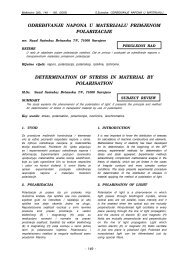
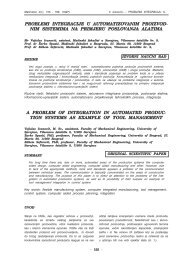

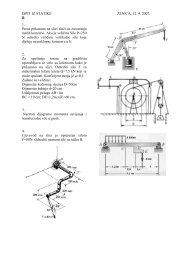
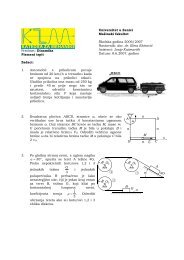
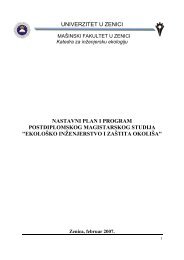
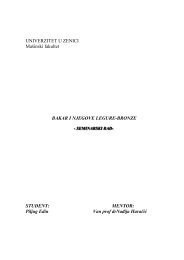
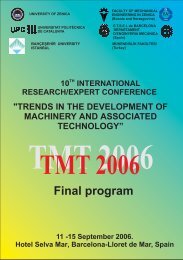
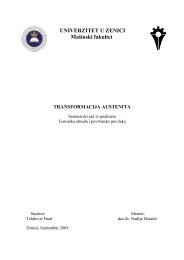
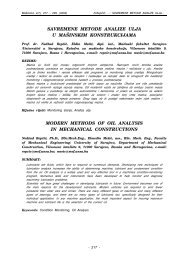
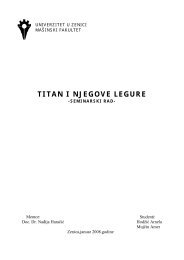
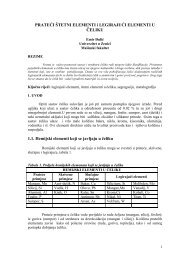
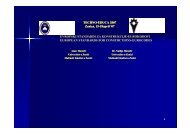
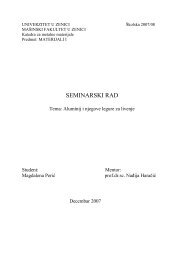
![zavarivanje kao metod produ@enja @ivotnog vijeka ku]i[ta toplotnih ...](https://img.yumpu.com/36506092/1/184x260/zavarivanje-kao-metod-produenja-ivotnog-vijeka-kuita-toplotnih-.jpg?quality=85)